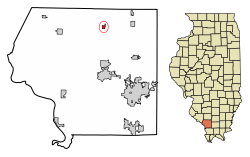Vergennes, Illinois
Vergennes, Illinois | |
|---|---|
 Location of Vergennes in Jackson County, Illinois | |
 Location of Illinois in the United States | |
| Coordinates: 37°54′11″N 89°20′24″W / 37.90306°N 89.34000°W | |
| Country | United States |
| State | Illinois |
| County | Jackson |
| Township | Vergennes |
| Area | |
| • Total | 0.35 sq mi (0.92 km2) |
| • Land | 0.35 sq mi (0.91 km2) |
| • Water | 0.00 sq mi (0.00 km2) |
| Elevation | 390 ft (120 m) |
| Population (2020) | |
| • Total | 235 |
| • Density | 667.61/sq mi (257.86/km2) |
| Time zone | UTC-6 (CST) |
| • Summer (DST) | UTC-5 (CDT) |
| ZIP Code(s) | 62994 |
| Area code | 618 |
| FIPS code | 17-77525 |
| GNIS feature ID | 2400057[2] |
| Wikimedia Commons | Vergennes, Illinois |
Vergennes is a village in Jackson County, Illinois, United States. The population was 298 at the 2010 census,[3] down from 491 at the 2000 census.
On February 28, 2017, a strong tornado, possibly the same as the one that struck Perryville, Missouri, narrowly missed the center of town, though no fatalities occurred.[citation needed]
Geography[edit]
Vergennes is located in northern Jackson County at 37°54′11″N 89°20′24″W / 37.90306°N 89.34000°W (37.903152, -89.340111).[4] Illinois Route 13 runs through the east side of the village, leading north 13 miles (21 km) to Pinckneyville and south 10 miles (16 km) to Murphysboro, the Jackson county seat.
According to the 2010 census, Vergennes has a total area of 0.352 square miles (0.91 km2), of which 0.35 square miles (0.91 km2) (or 99.43%) is land and 0.002 square miles (0.01 km2) (or 0.57%) is water.[5]
Demographics[edit]
| Census | Pop. | Note | %± |
|---|---|---|---|
| 1890 | 275 | — | |
| 1900 | 416 | 51.3% | |
| 1910 | 342 | −17.8% | |
| 1920 | 305 | −10.8% | |
| 1930 | 309 | 1.3% | |
| 1940 | 324 | 4.9% | |
| 1950 | 312 | −3.7% | |
| 1960 | 298 | −4.5% | |
| 1970 | 323 | 8.4% | |
| 1980 | 360 | 11.5% | |
| 1990 | 314 | −12.8% | |
| 2000 | 491 | 56.4% | |
| 2010 | 298 | −39.3% | |
| 2020 | 235 | −21.1% | |
| U.S. Decennial Census[6] | |||
As of the census[7] of 2000, there were 491 people, 120 households, and 93 families residing in the village. The population density was 1,357.6 inhabitants per square mile (524.2/km2). There were 127 housing units at an average density of 351.2 per square mile (135.6/km2). The racial makeup of the village was 73.32% White, 22.40% African American, 1.22% Native American, 0.41% Asian, 1.22% from other races, and 1.43% from two or more races. Hispanic or Latino of any race were 4.28% of the population.
There were 120 households, out of which 50.0% had children under the age of 18 living with them, 58.3% were married couples living together, 14.2% had a female householder with no husband present, and 22.5% were non-families. 19.2% of all households were made up of individuals, and 10.8% had someone living alone who was 65 years of age or older. The average household size was 2.75 and the average family size was 3.16.
In the village, the population was spread out, with 52.1% under the age of 18, 7.1% from 18 to 24, 23.6% from 25 to 44, 10.8% from 45 to 64, and 6.3% who were 65 years of age or older. The median age was 18 years. For every 100 females, there were 194.0 males. For every 100 females age 18 and over, there were 104.3 males.
The median income for a household in the village was $36,458, and the median income for a family was $39,028. Males had a median income of $27,500 versus $18,333 for females. The per capita income for the village was $8,574. About 16.9% of families and 19.1% of the population were below the poverty line, including 25.0% of those under age 18 and 31.6% of those age 65 or over.
References[edit]
- ^ "2020 U.S. Gazetteer Files". United States Census Bureau. Retrieved March 15, 2022.
- ^ a b U.S. Geological Survey Geographic Names Information System: Vergennes, Illinois
- ^ "Geographic Identifiers: 2010 Census Summary File 1 (G001): Vergennes village, Illinois". American Factfinder. U.S. Census Bureau. Archived from the original on February 13, 2020. Retrieved May 10, 2018.
- ^ "US Gazetteer files: 2010, 2000, and 1990". United States Census Bureau. February 12, 2011. Retrieved April 23, 2011.
- ^ "G001 - Geographic Identifiers - 2010 Census Summary File 1". United States Census Bureau. Archived from the original on February 13, 2020. Retrieved December 25, 2015.
- ^ "Census of Population and Housing". Census.gov. Retrieved June 4, 2015.
- ^ "U.S. Census website". United States Census Bureau. Retrieved January 31, 2008.

